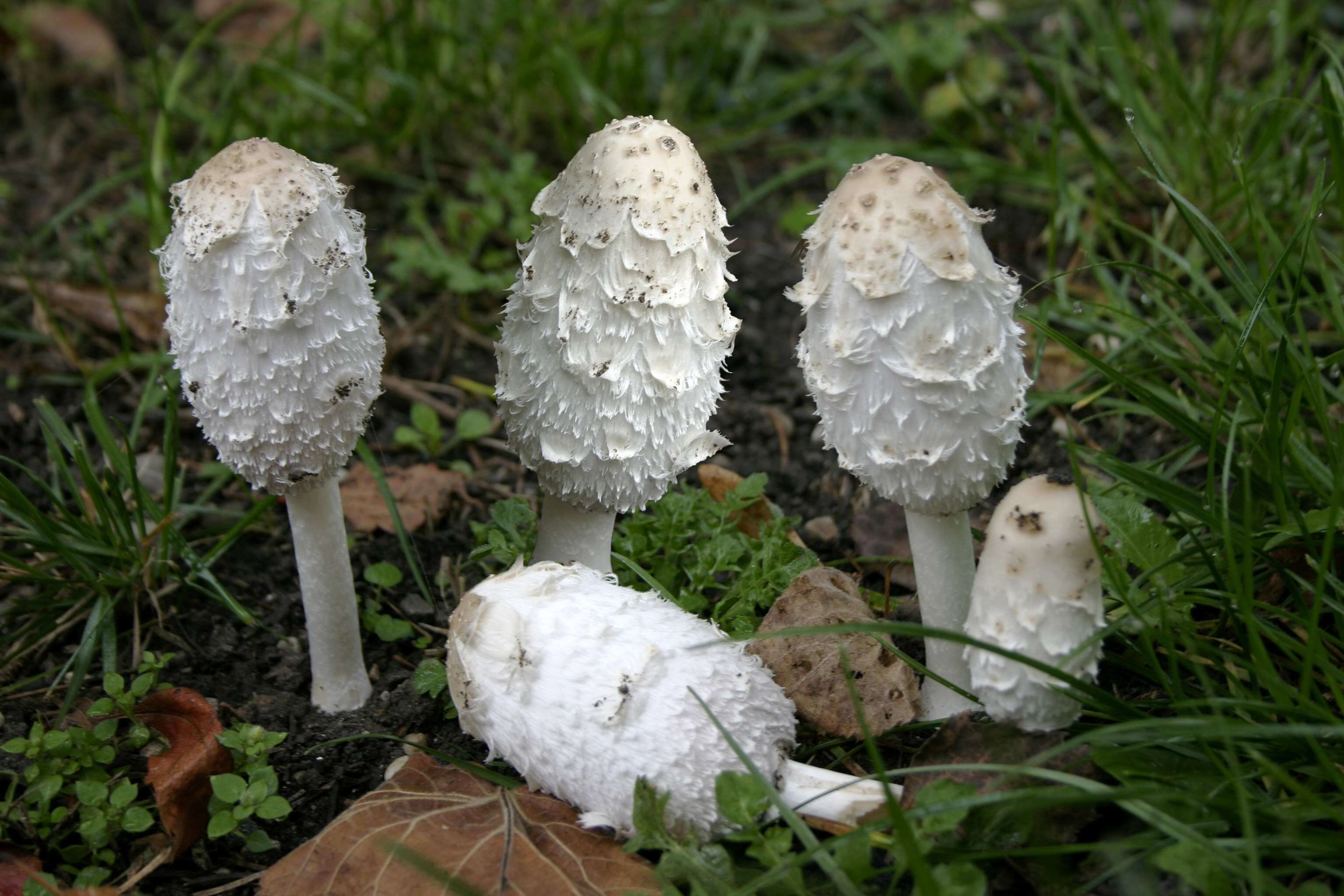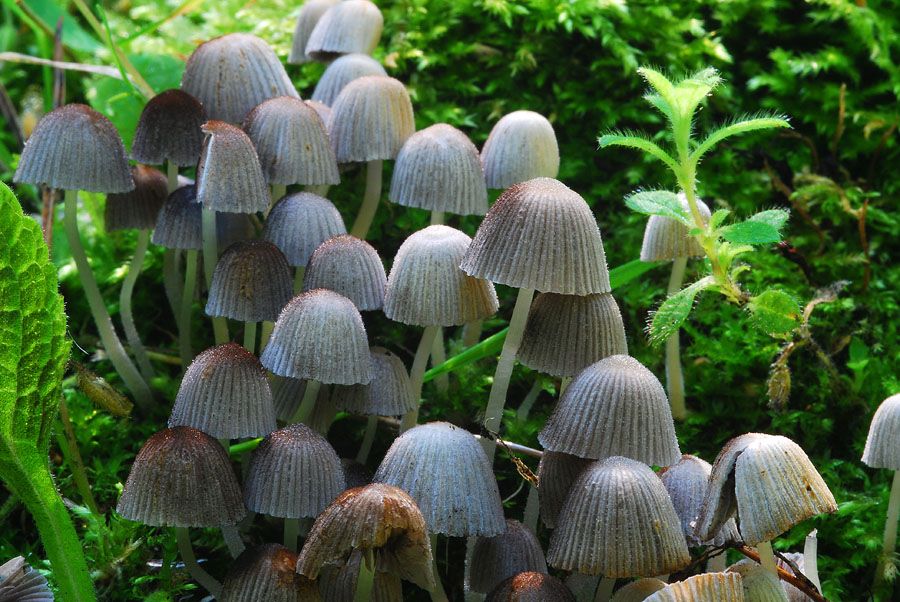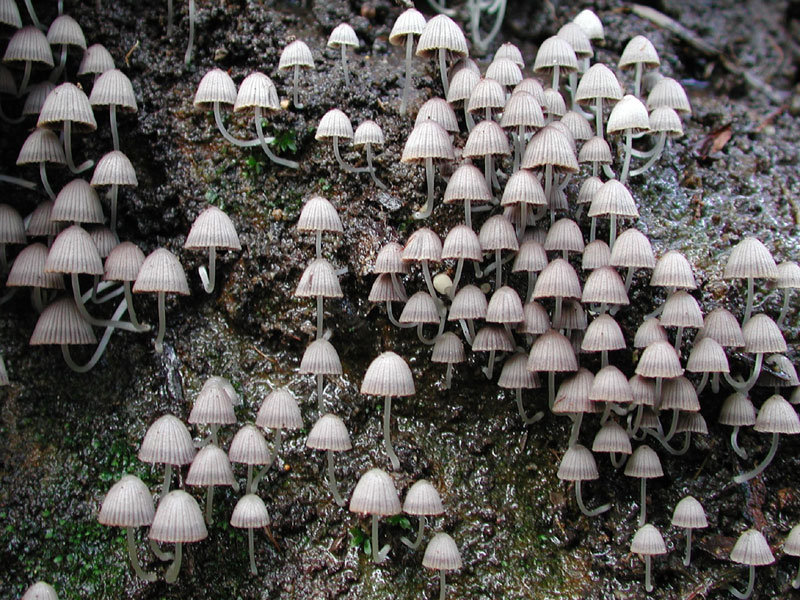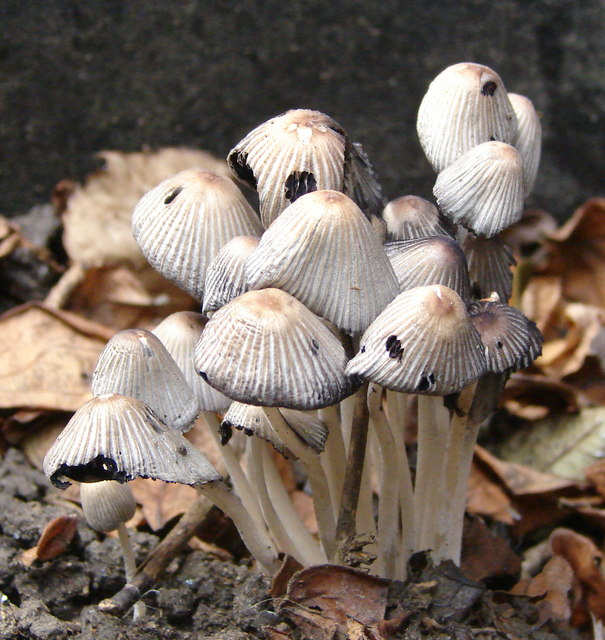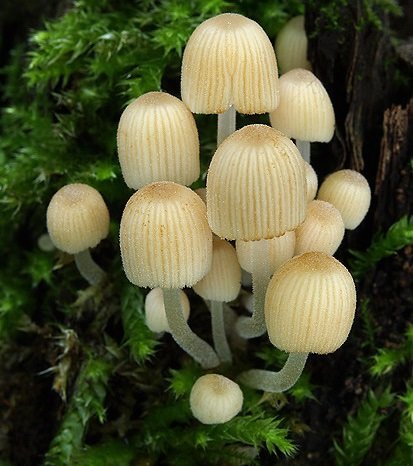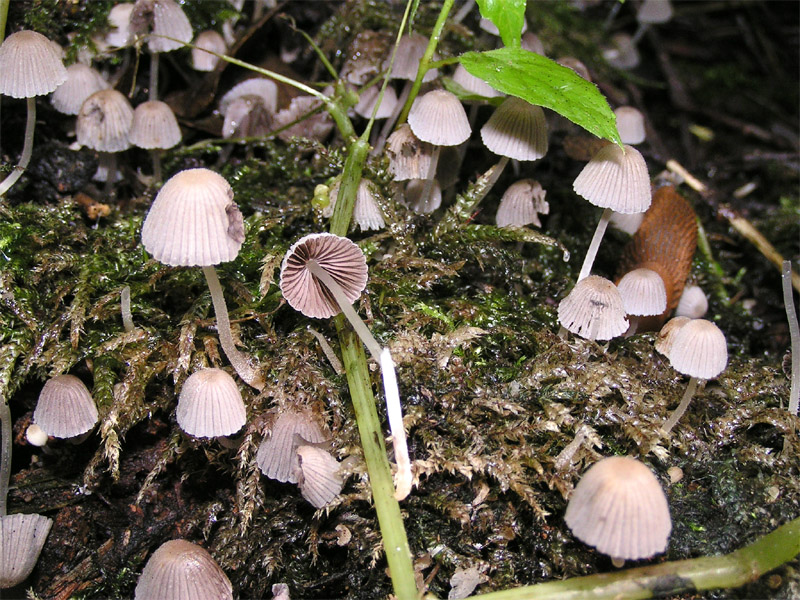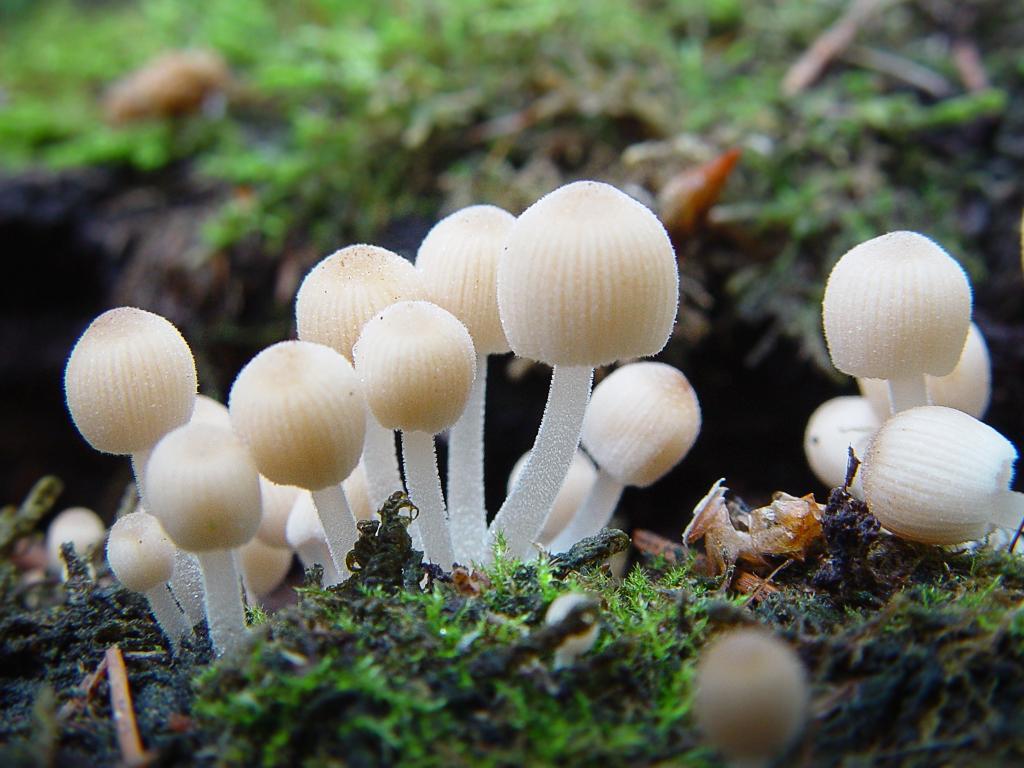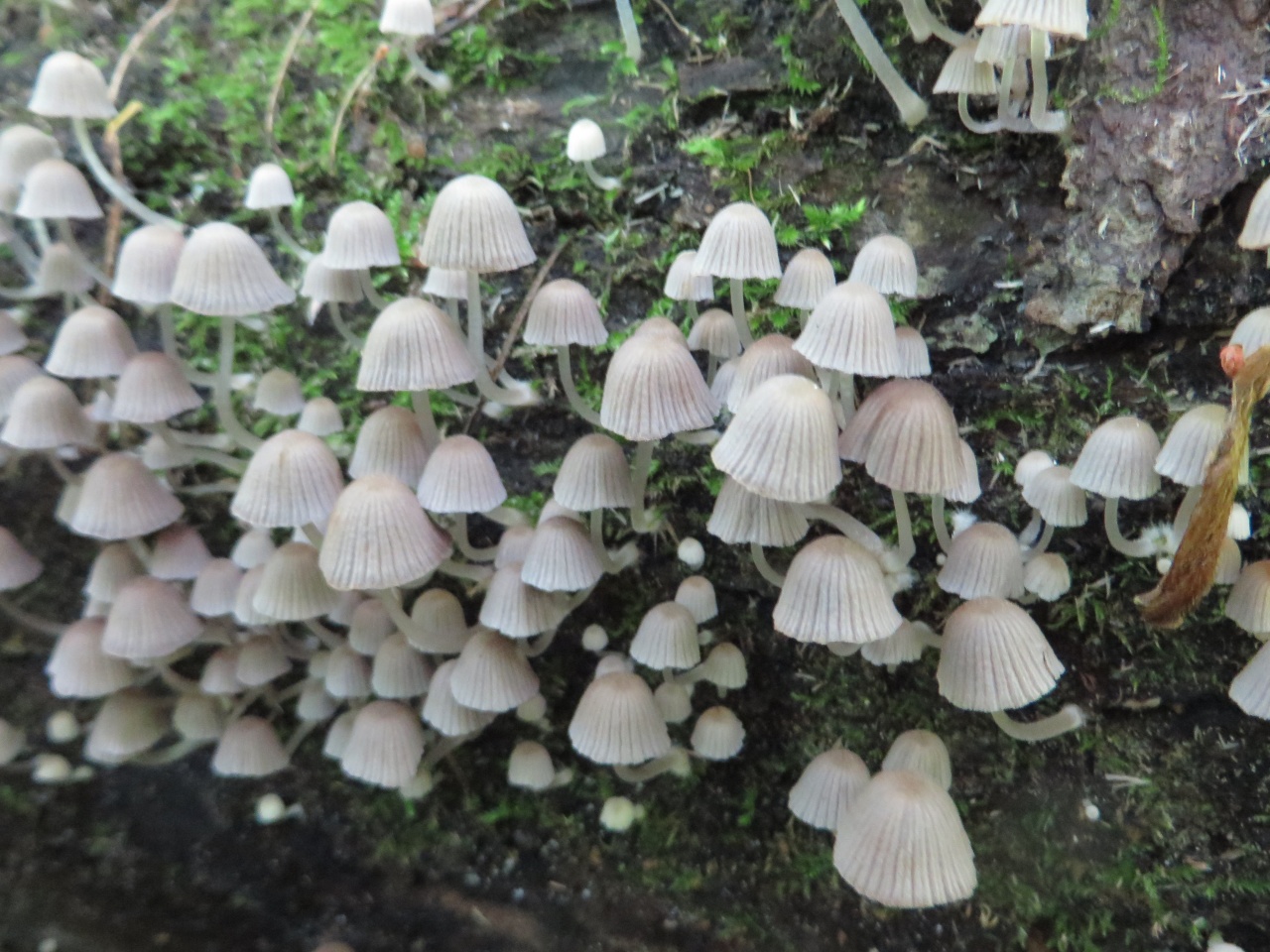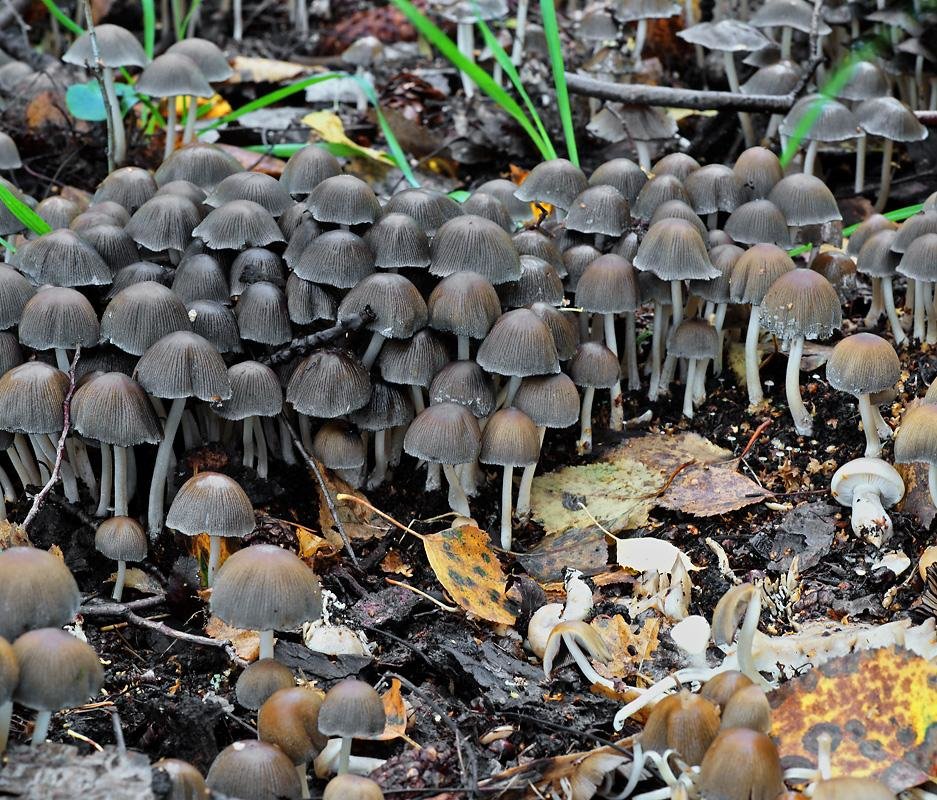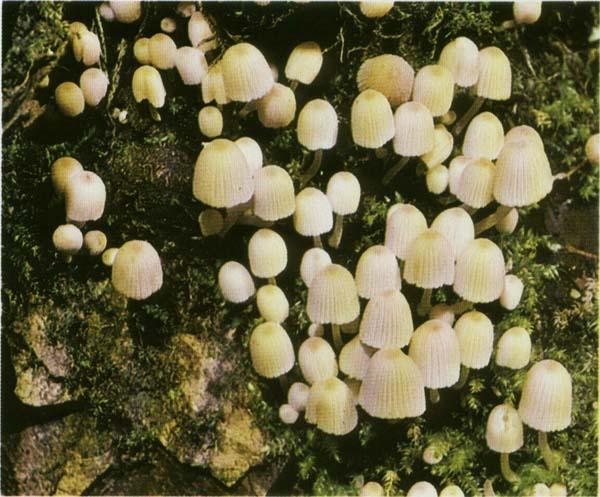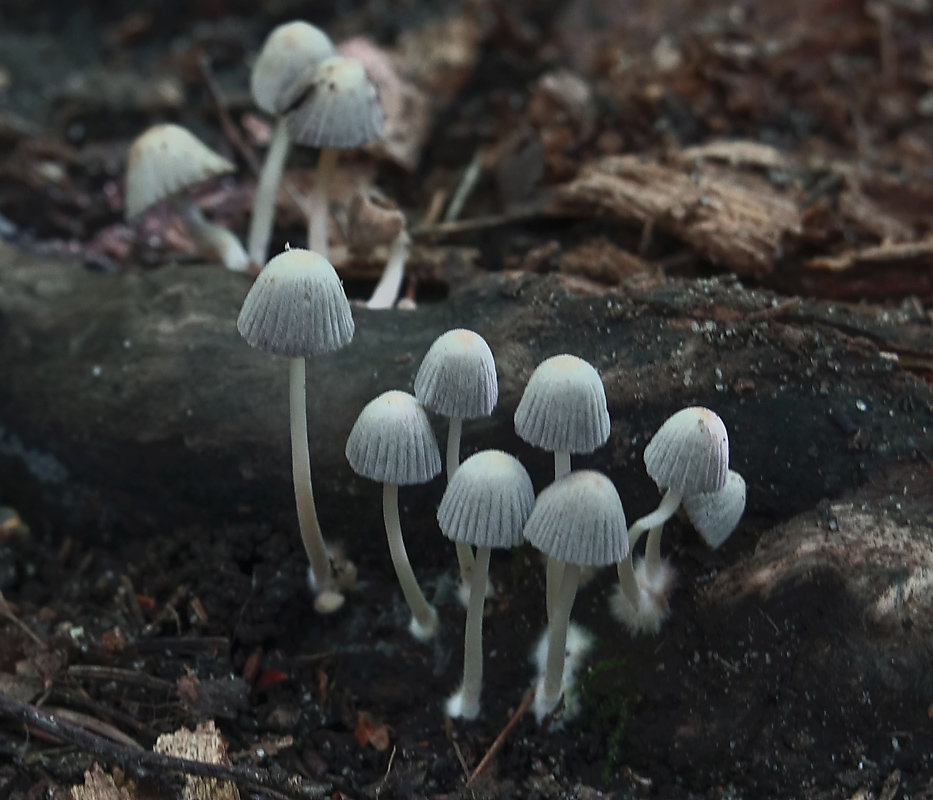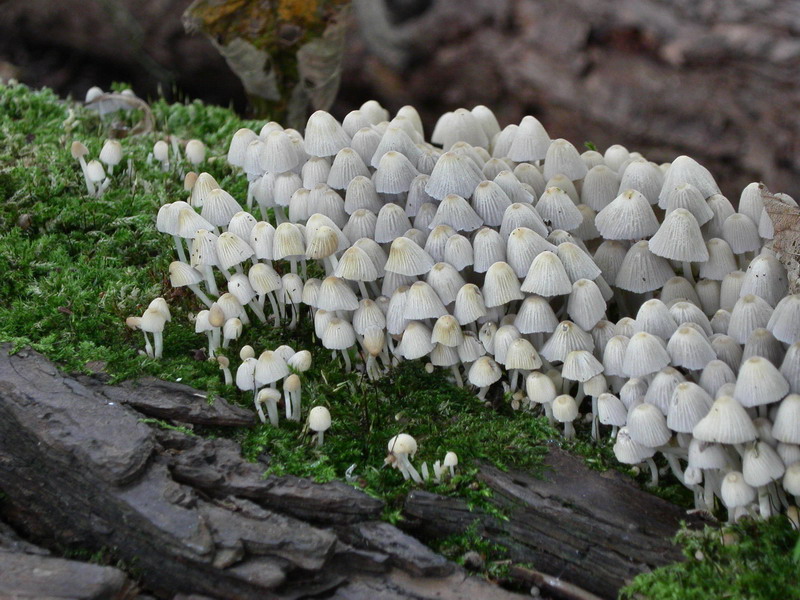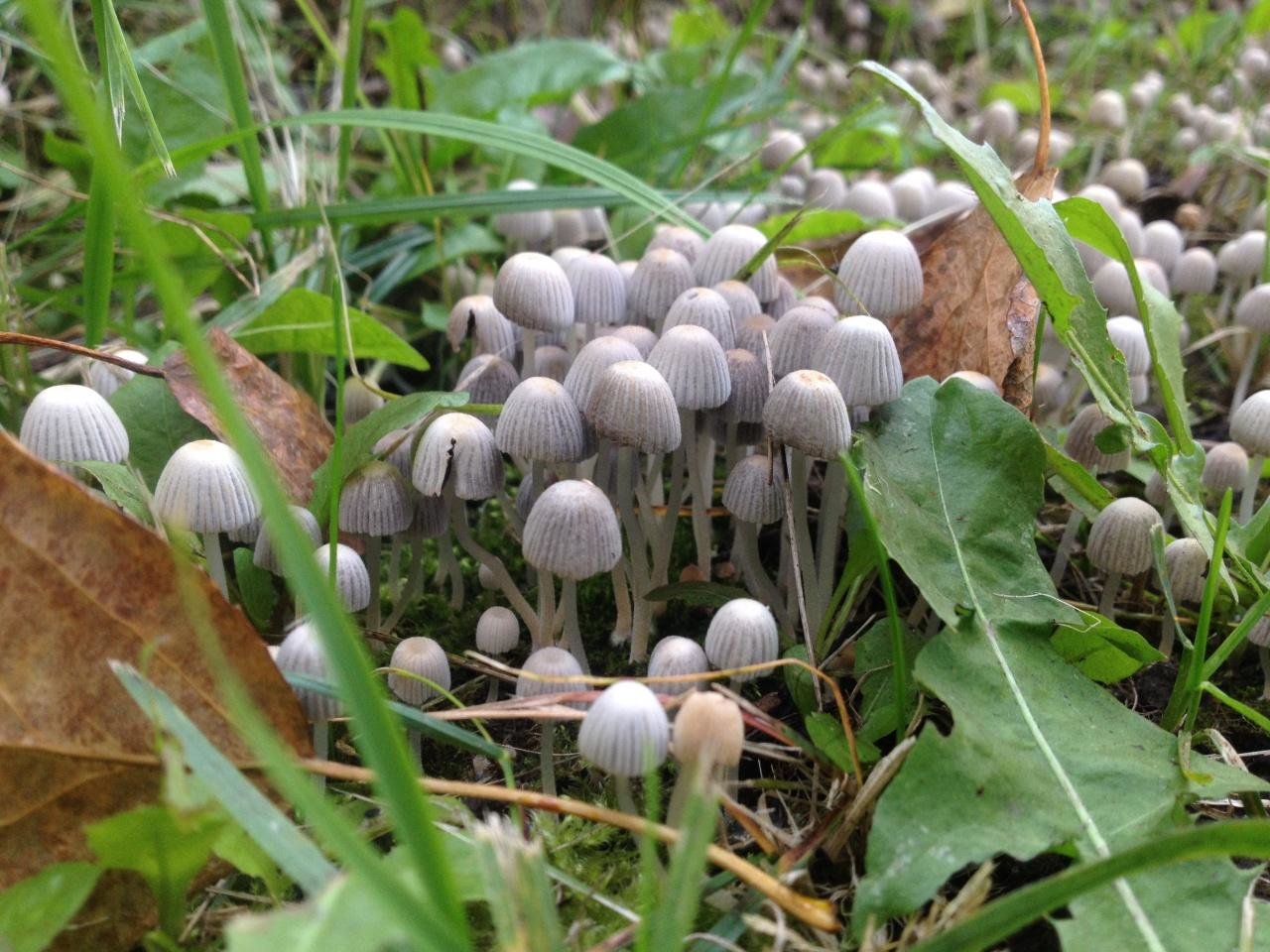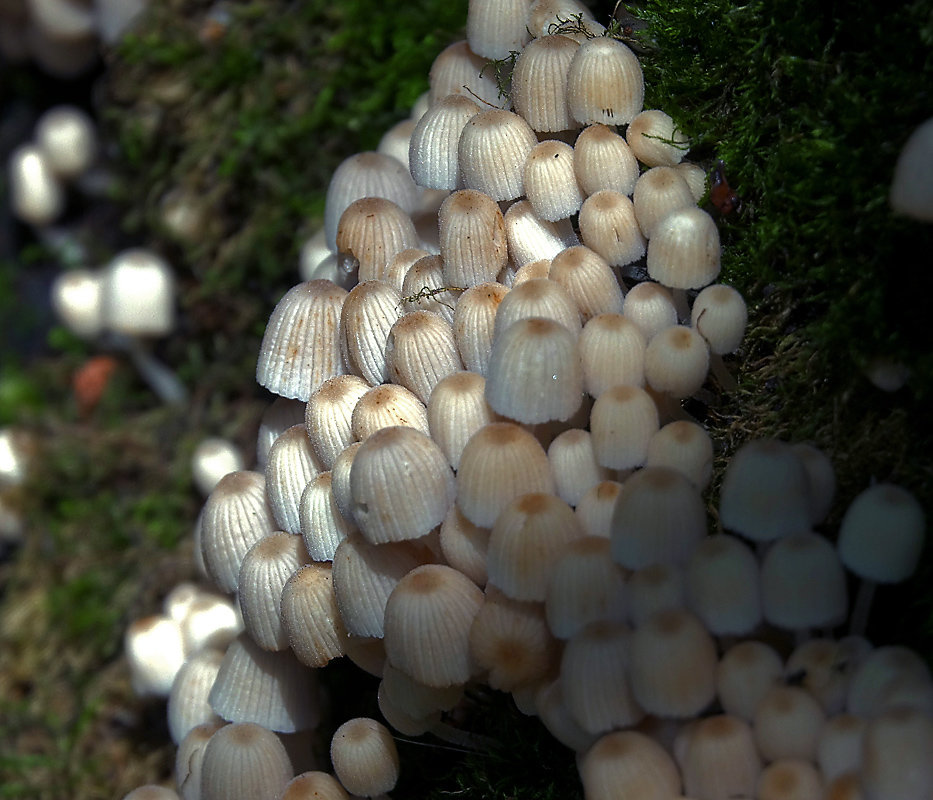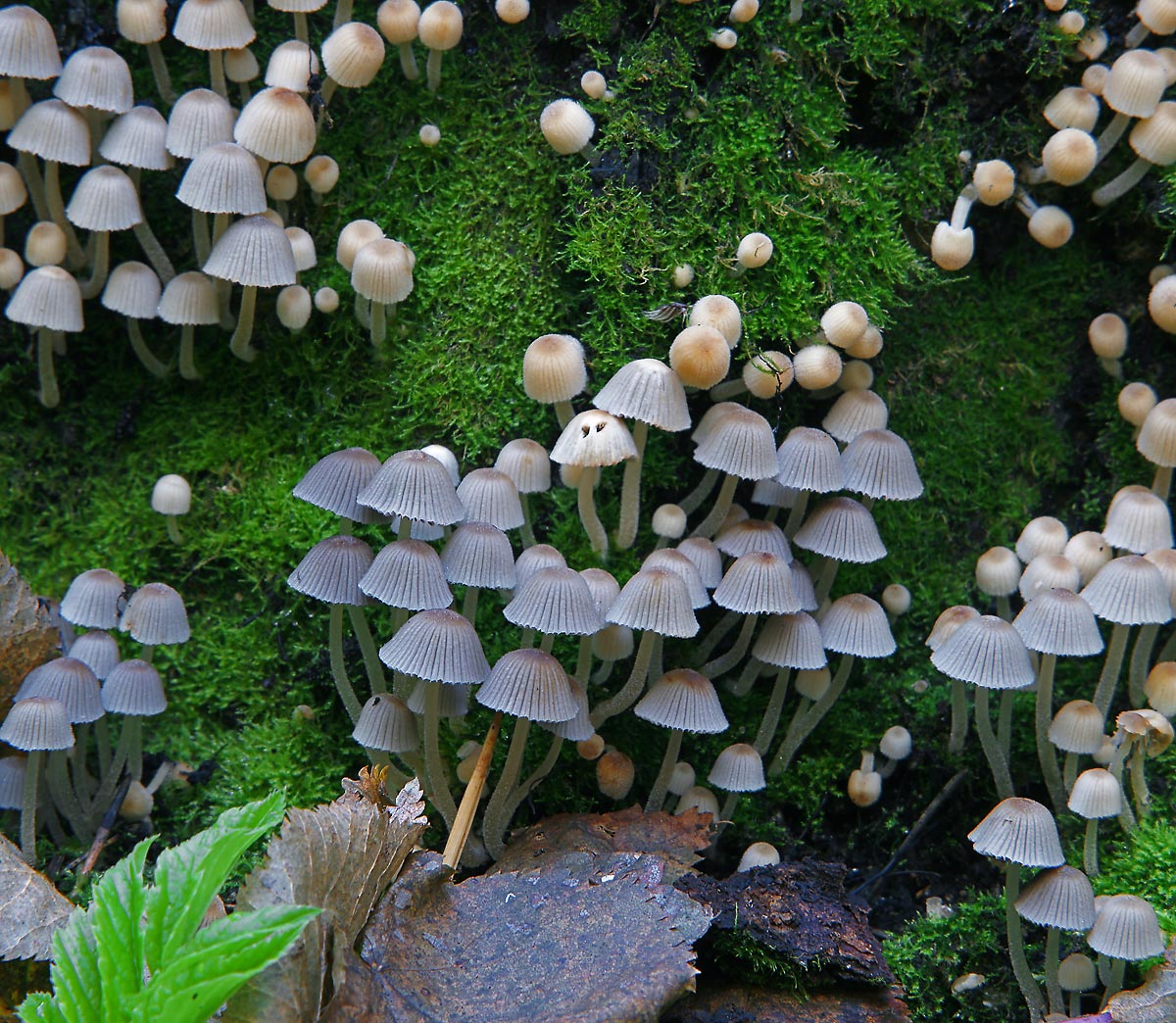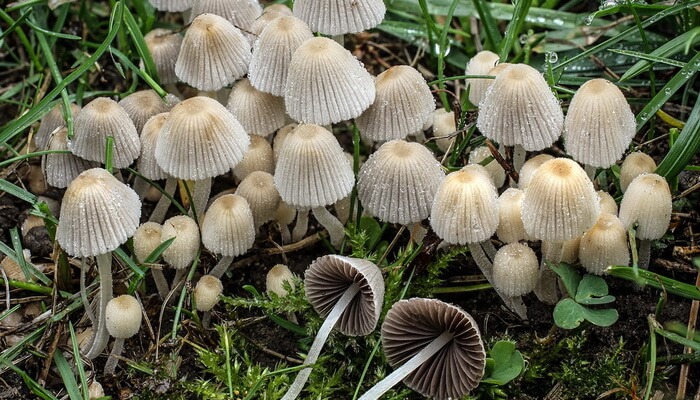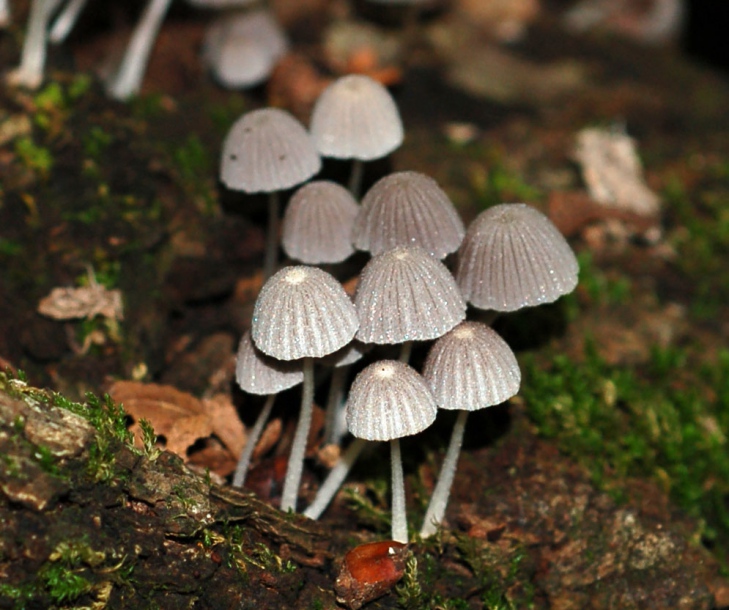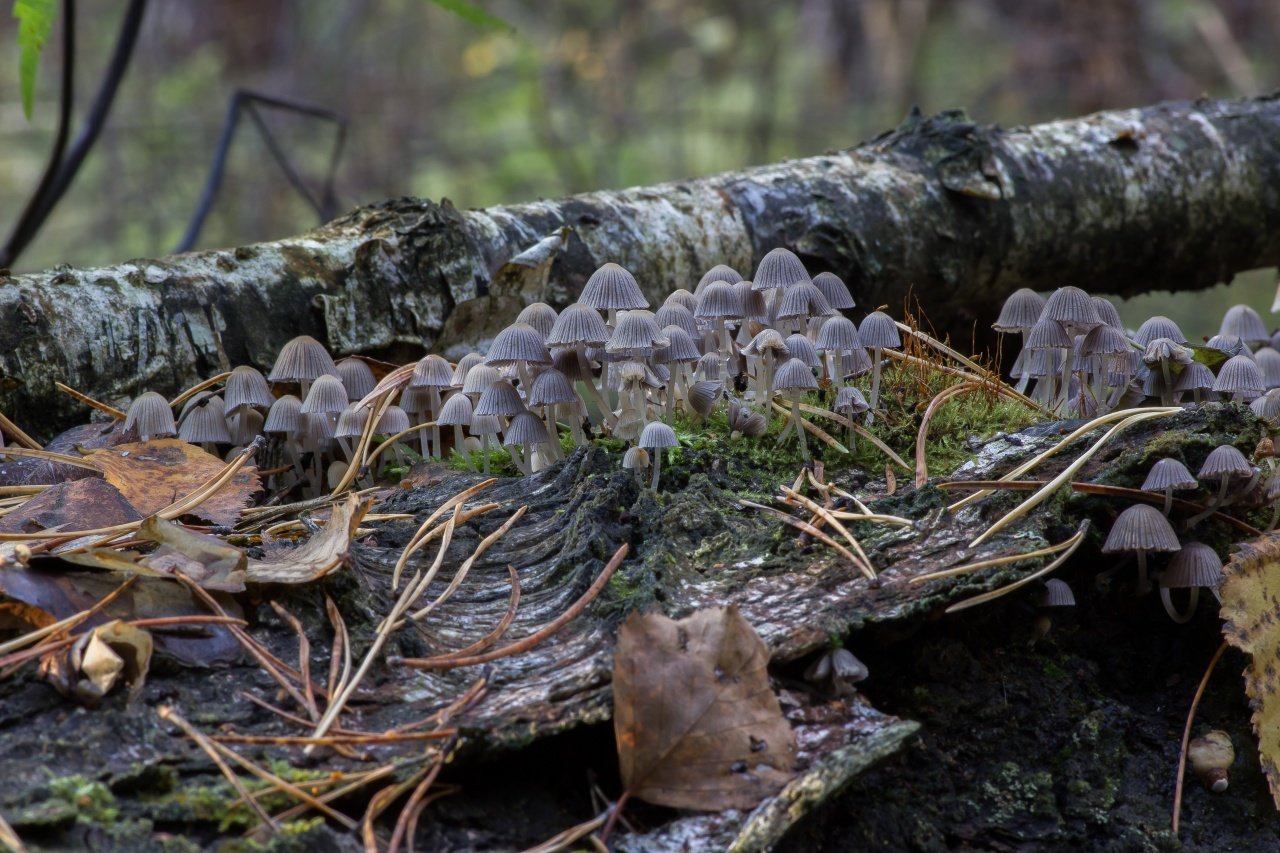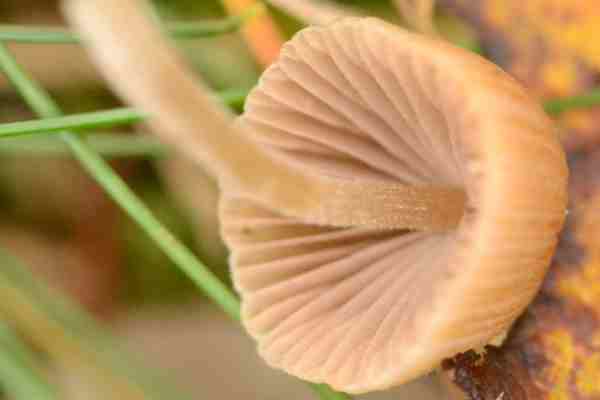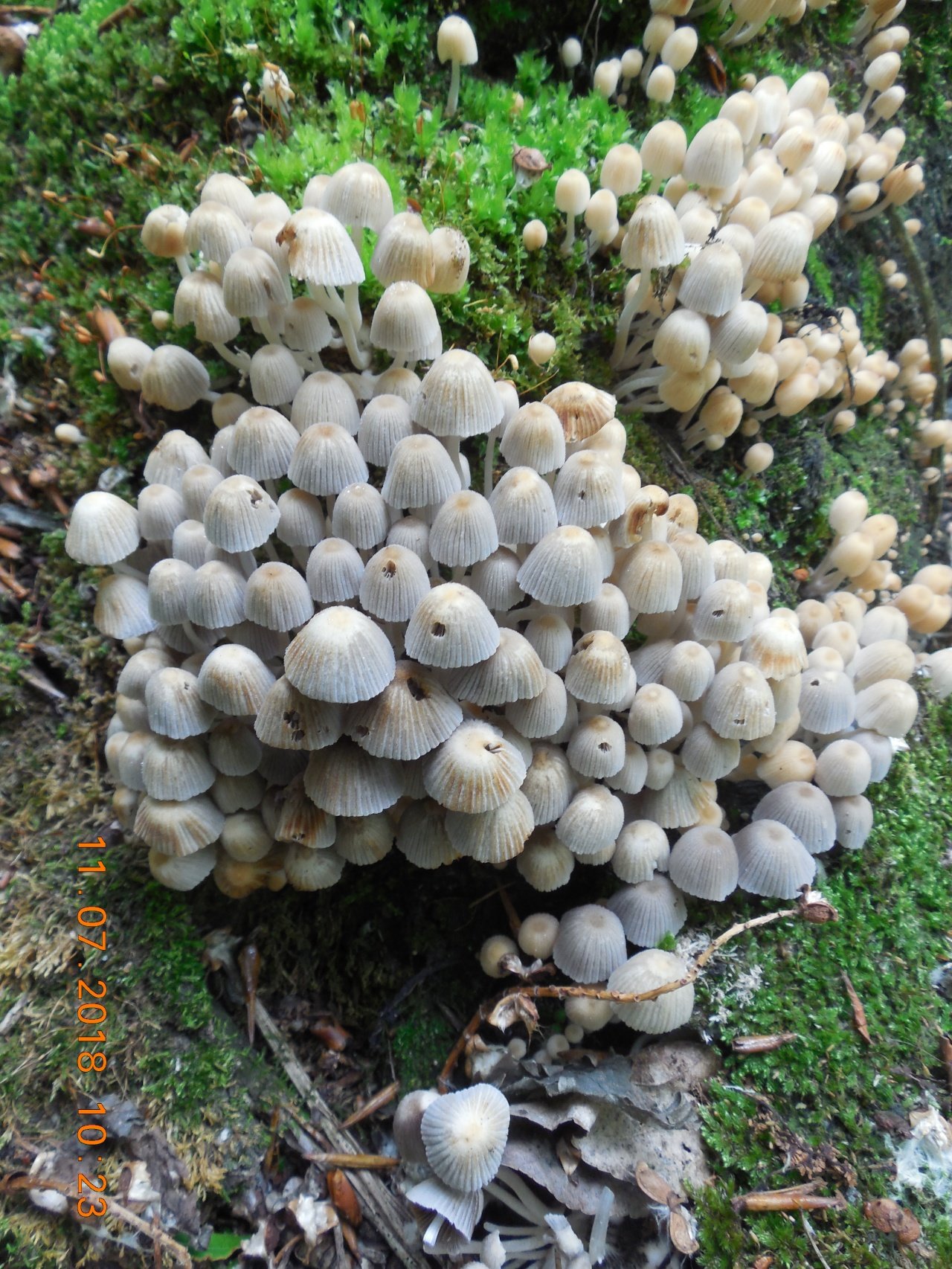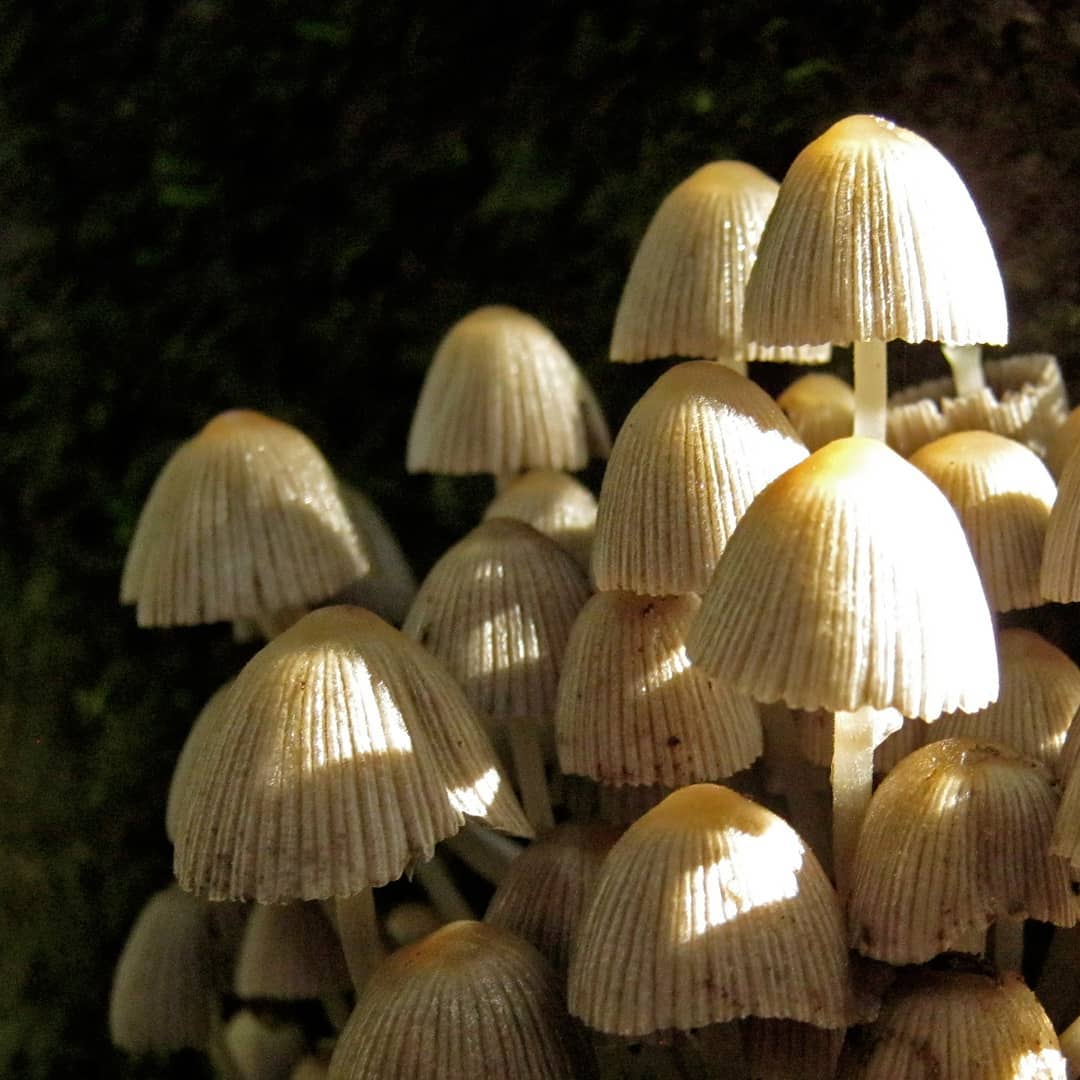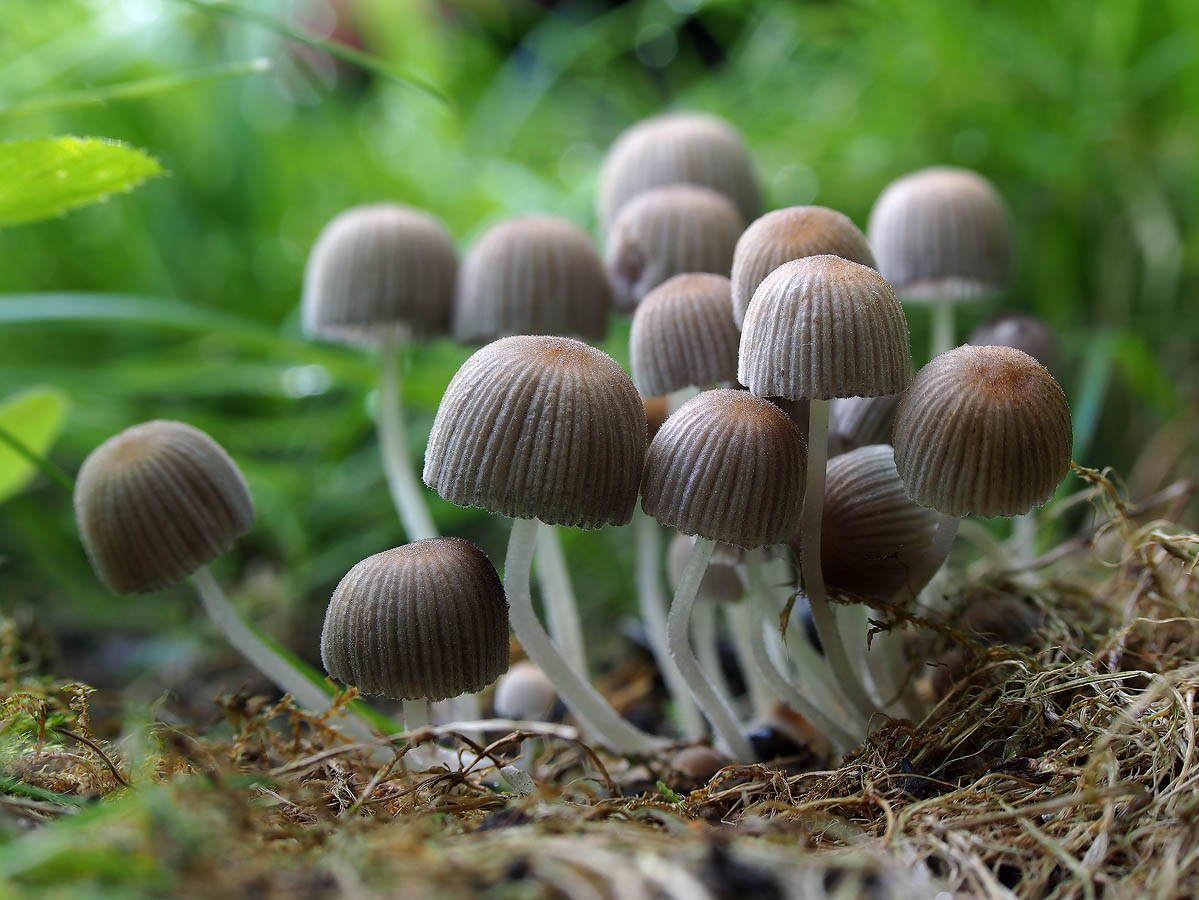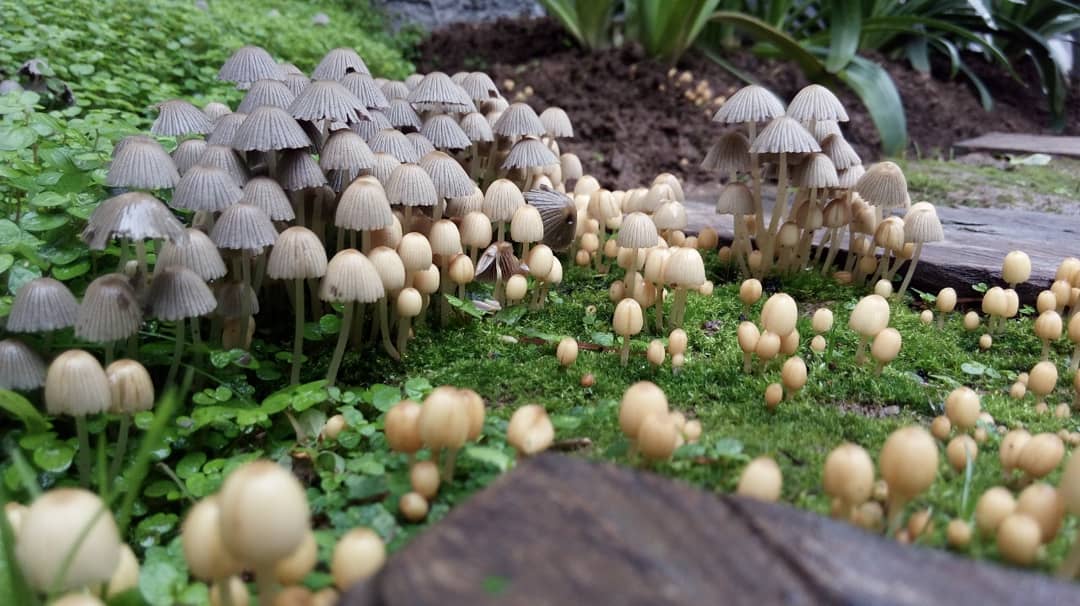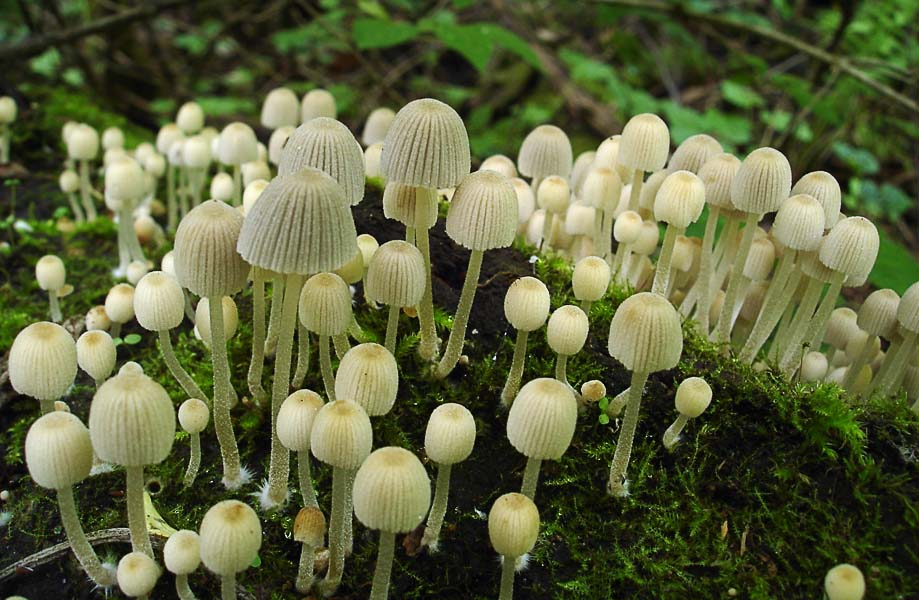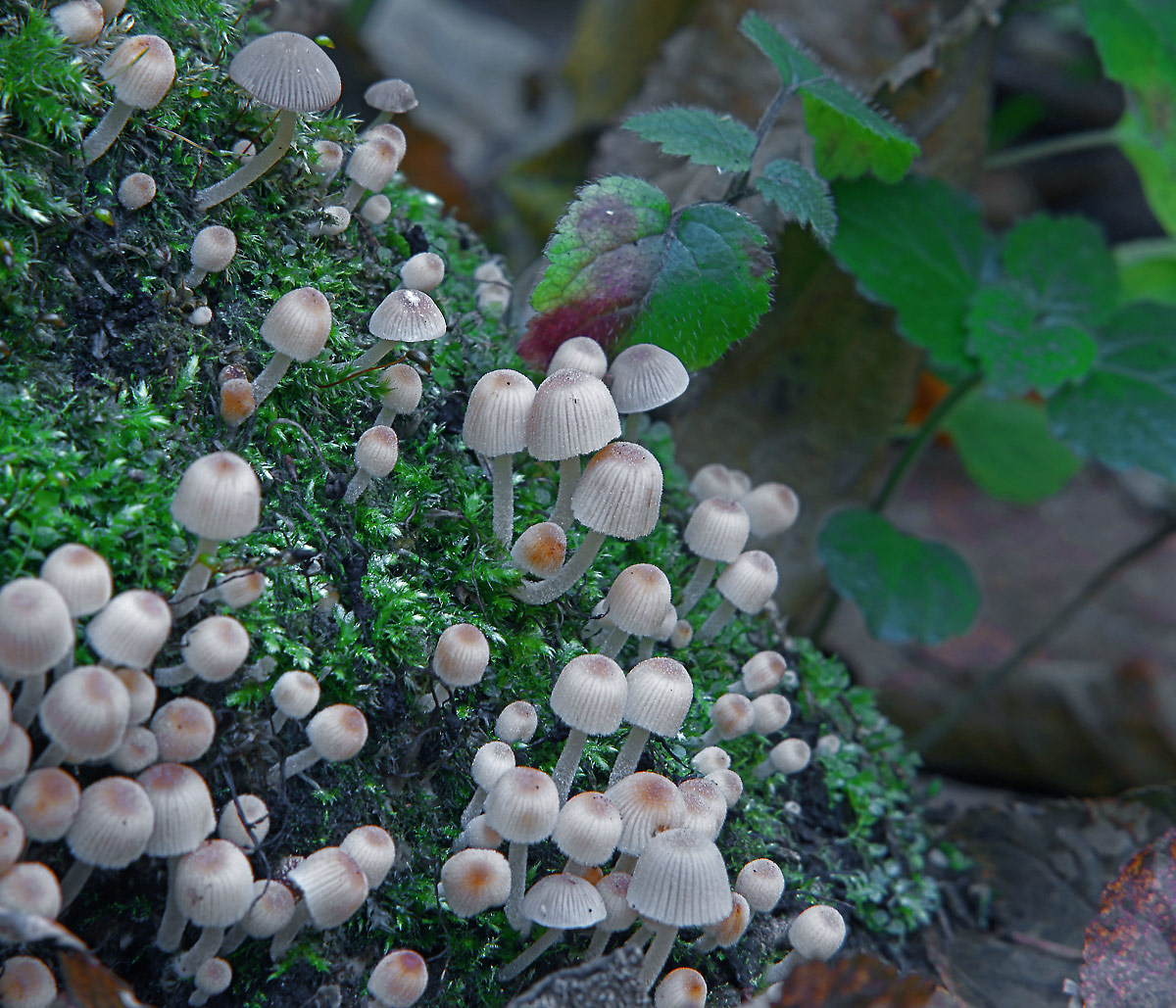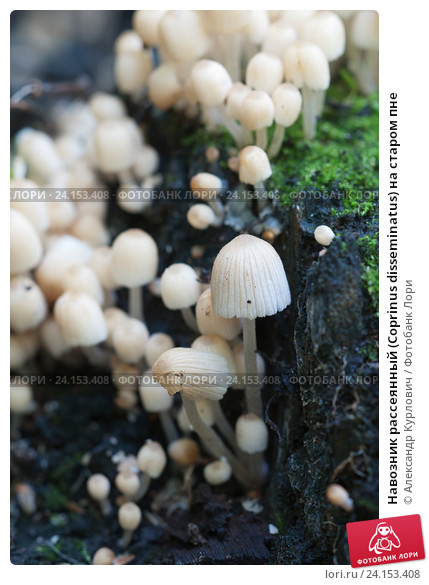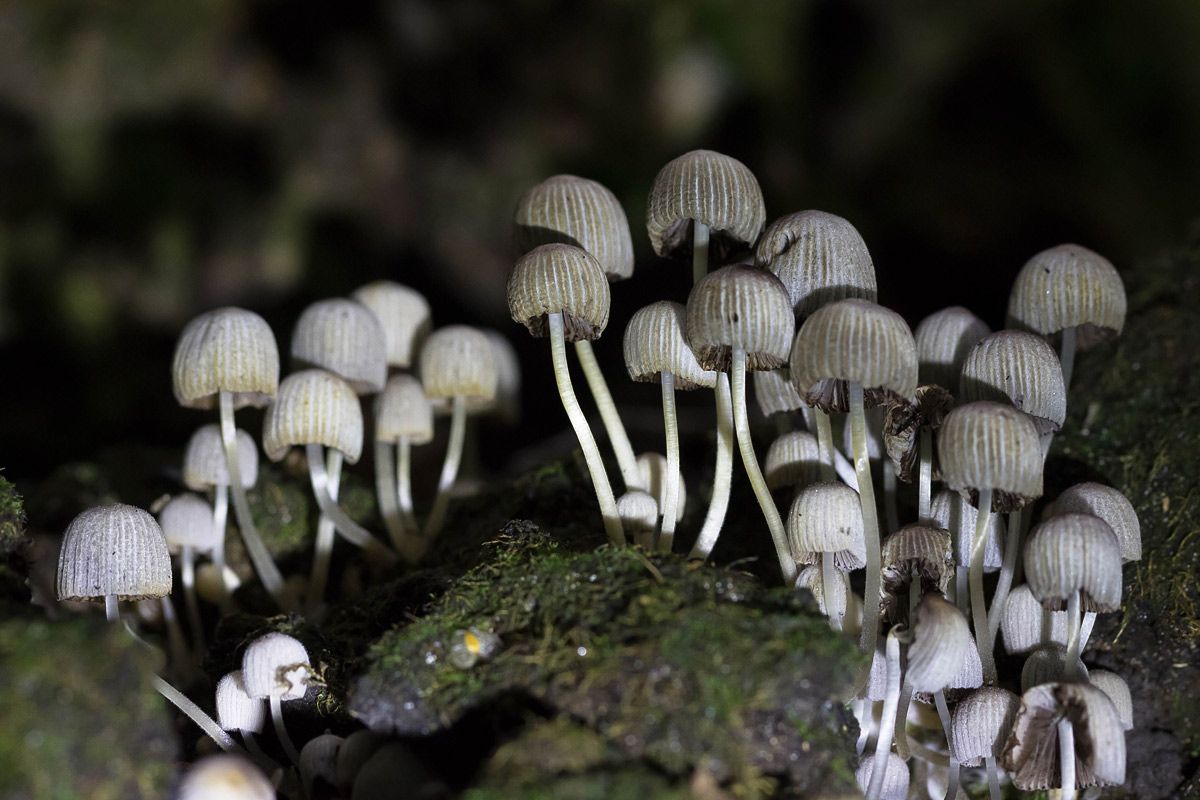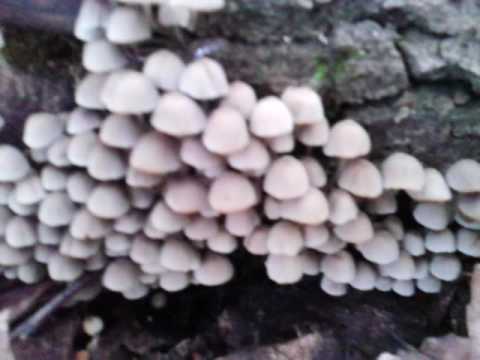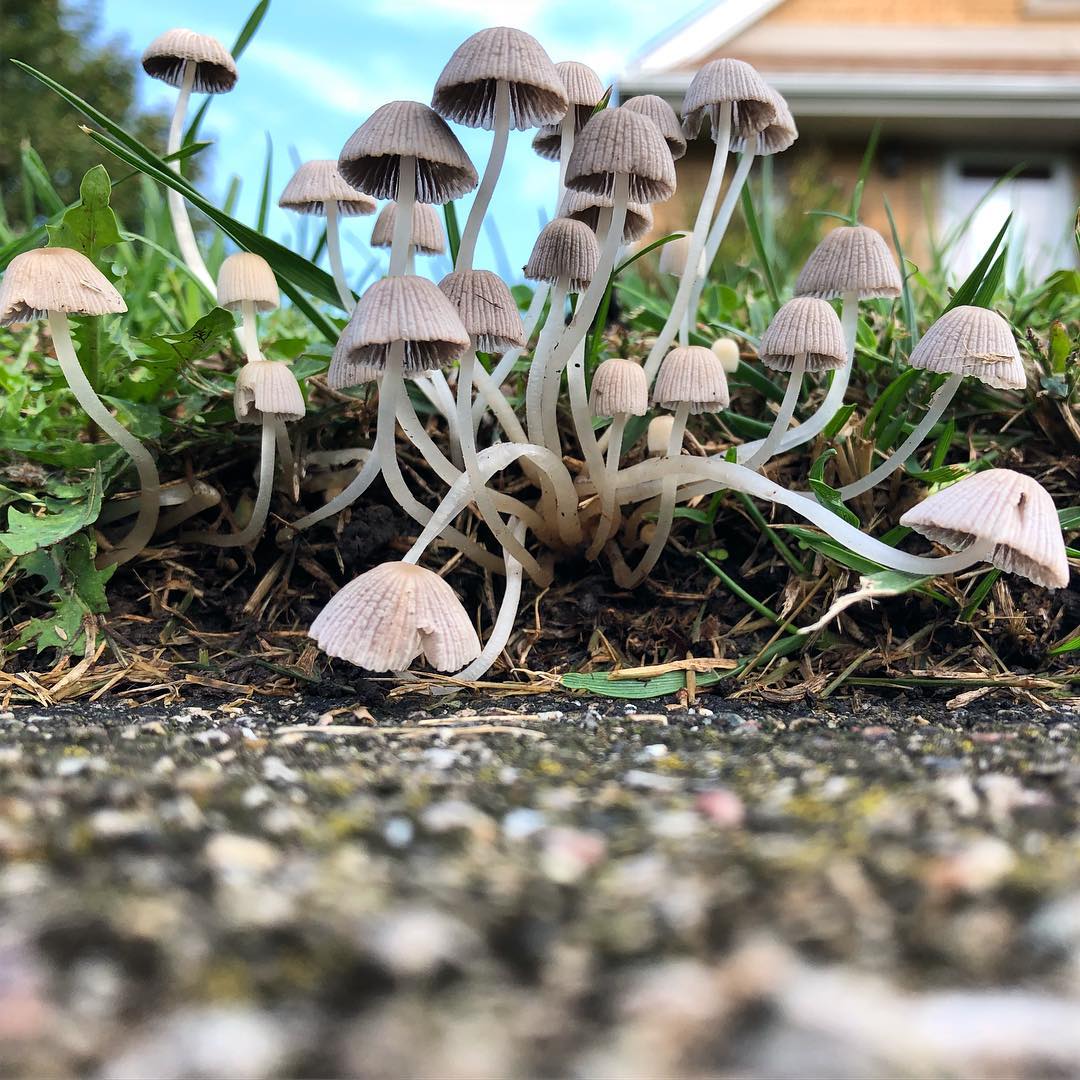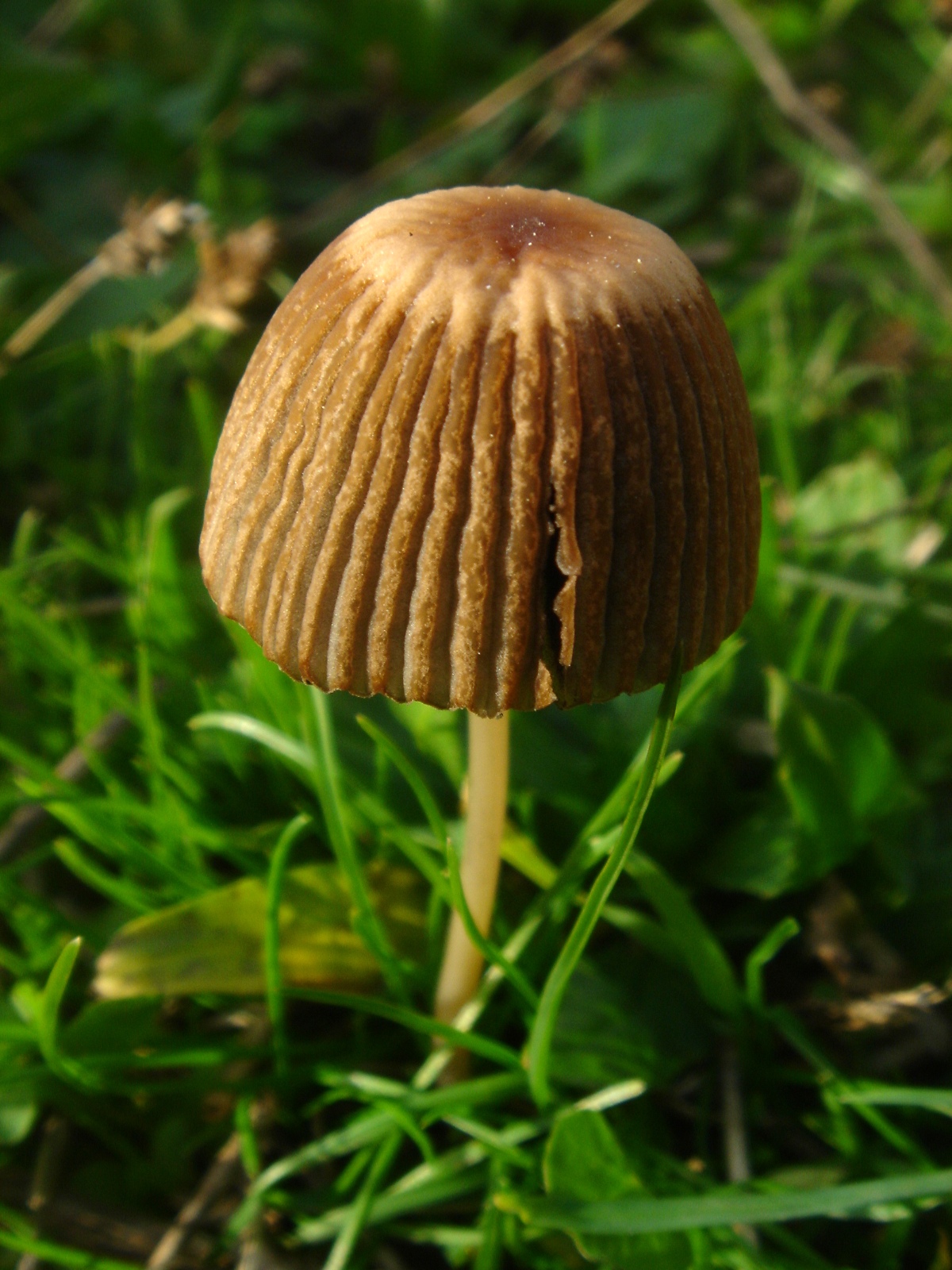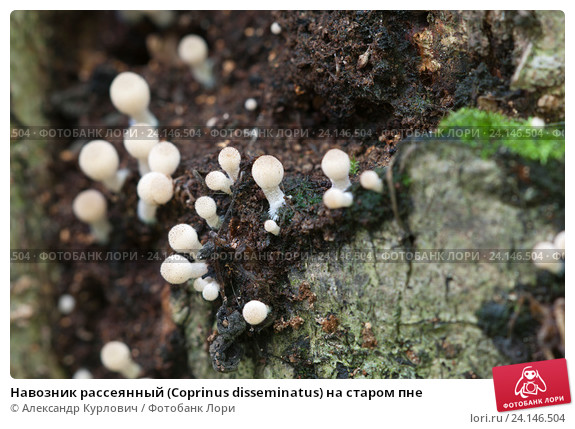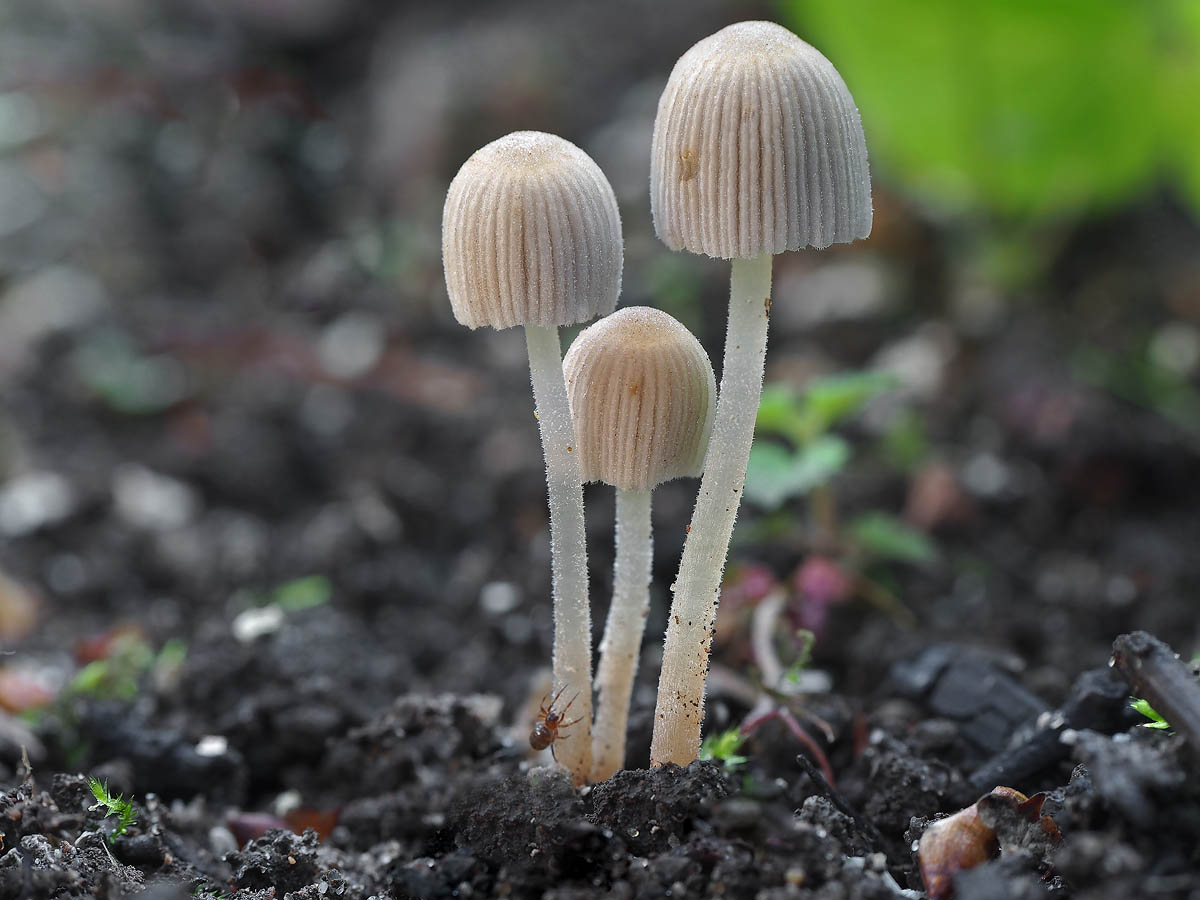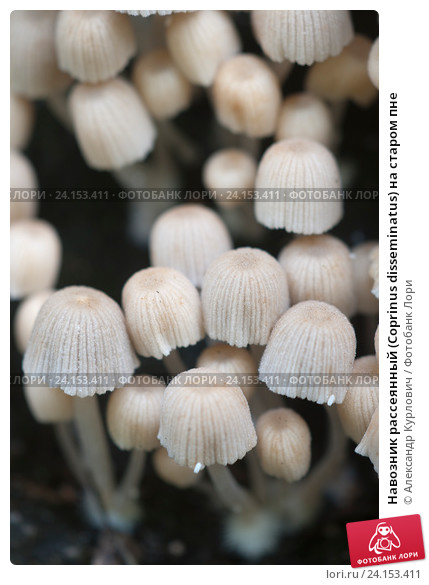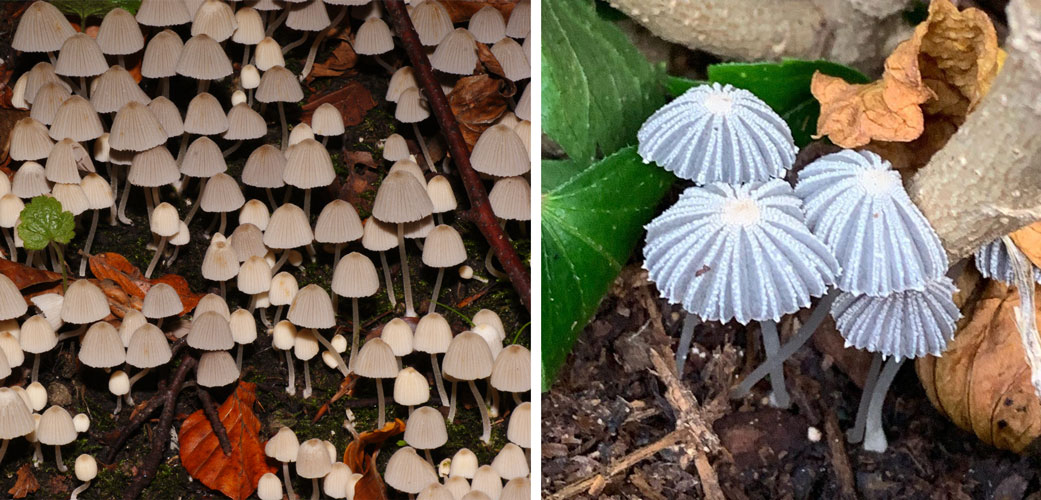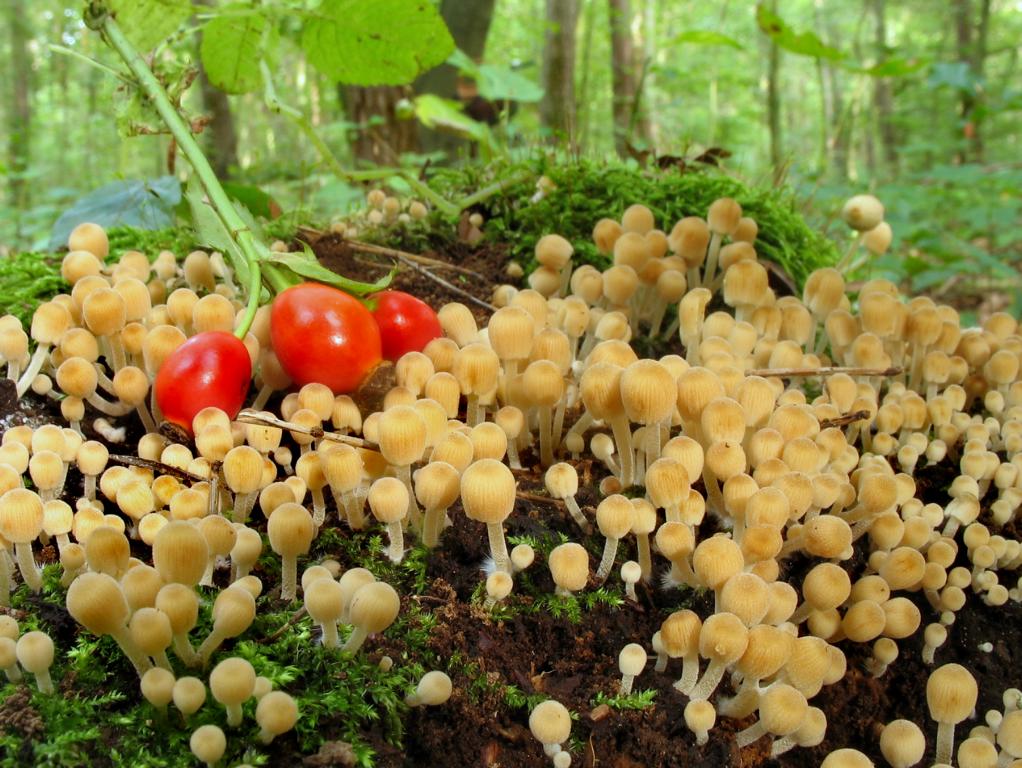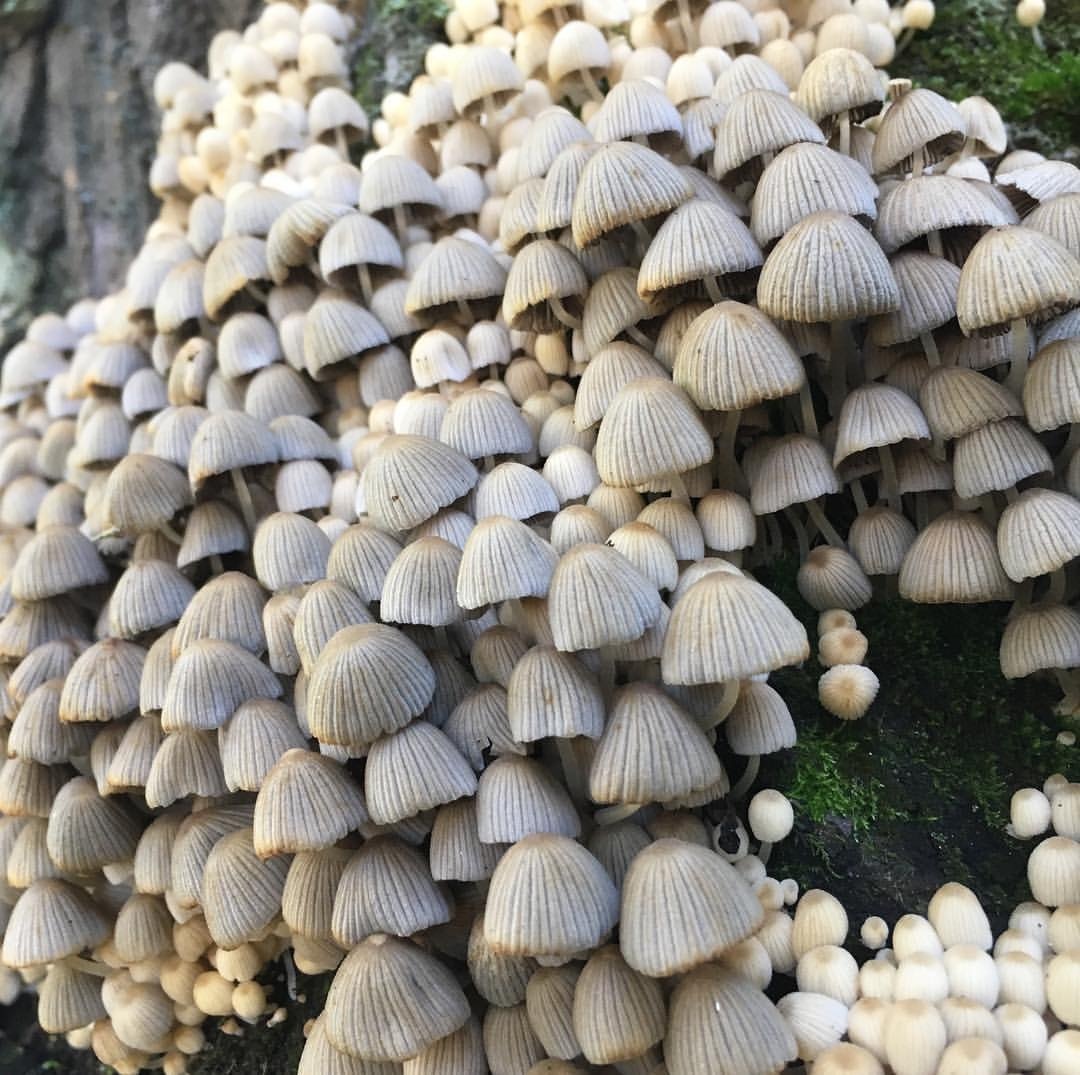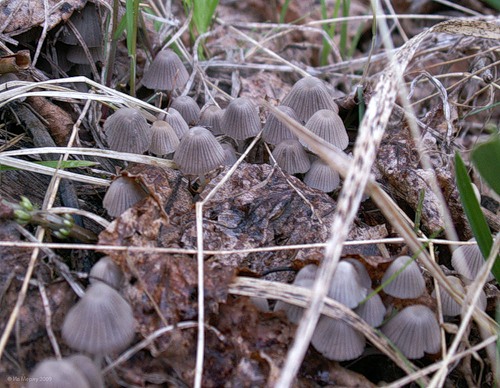Doubles
The dung beetle has striking characteristic features and is well recognized. Similarities to other mushrooms are present within the family. It is impossible to name their exact number, since some representatives are transferred to other genera, groups.
By morphological features, the crumbling dung is similar to the domestic dung. True, the latter has a red mycelium on a stalk and lives separately. Related links can be found with the willow ink fungus, but its cap is wrinkled and has a veil at the base. It is difficult even for professionals to determine the differences with willow dung beetle.
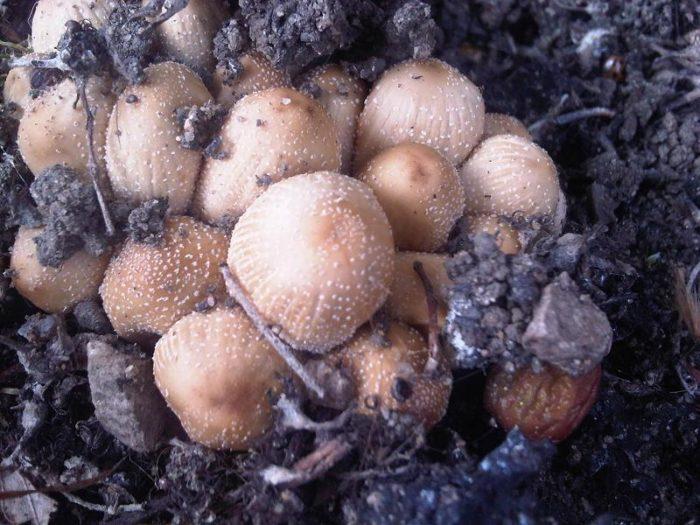 Home dung
Home dung
White dung beetle (Coprinus comatus)
or
Ink mushroom
Dung beetle (Latin Coprinus comatus) is a mushroom of the genus Dung (Latin Coprinus) of the Dung family.
Hat:
Height 5-12 cm, shaggy, white, fusiform at first, then bell-shaped, practically does not straighten. There is usually a darker bump in the center of the cap, which, like the captain, is the last to disappear when the cap of the mushroom comes out on the ink. The smell and taste are pleasant.
Plates:
Frequent, free, white, turn pink with age, then turn black and turn into "ink", which is characteristic of almost all dung beetles.
Spore powder:
Black.
Leg:
Length up to 15 cm, thickness 1-2 cm, white, hollow, fibrous, relatively thin, with a white movable ring (not always clearly visible).
Spreading:
White dung is found from May to autumn, sometimes in enchanting quantities, in fields, vegetable gardens, orchards, lawns, in garbage dumps, dumps, dung heaps, as well as along roads. Occasionally comes across in the forest.
Similar species:
White dung beetle (Coprinus comatus) is almost impossible to confuse with anything.
Edibility:
Great mushroom. However, it should be remembered that you can only pick mushrooms that have not yet begun to fulfill their Great Mission - to self-digest, to turn into ink. The plates must be white. True, nowhere is it said what will happen if you eat (eat, as they say in special editions) dung beetle, which has already started the process of autolysis. However, there are hardly any who wish. It is believed that white dung is edible only at a young age, before the staining of the plates begins, no later than two days after it emerged from the soil. It is necessary to process it no later than 1-2 hours after collection, since the autolysis reaction continues even in frozen mushrooms. It is recommended to pre-boil it as conditionally edible, although there are claims that the mushroom is edible even in its raw form. It is also not recommended to mix dung beetles with other mushrooms.
It should also be noted that according to scientific data, garbage saprophytes like dung beetles with special enthusiasm pull all kinds of harmful products of human activity from the soil. Consequently, it is impossible to collect dung beetles in the city, as well as near highways.
By the way, it was previously believed that Coprinus comatus contains substances incompatible with alcohol, and therefore, in a sense, poisonous (although, for that matter, alcohol itself is poisonous, not the mushroom). Now it is quite obvious that this is not the case, although sometimes this old delusion pops up in the literature. Many other dung beetles like Gray (Coprinus atramentarius) or Shimmering (Coprinus micaceus) are advocating a healthy lifestyle, although this is not certain. But the White Dung, fortunately or unfortunately, is deprived of this property. That's for sure.
Notes: I have many childhood memories associated with the dung beetle. In the second class, in the fall, I somehow unexpectedly became a big enthusiast of "city mushrooms", spending whole days in search of dung beetles and champignons. I knew all the yards in my neighborhood, I had a lot of volunteers. They laughed at me, of course, but for some reason they willingly helped.
At home my inclinations were fully supported. Oddly enough, in terms of mushrooms, they completely trusted me even then, and every autumn for several years in a row dung beetles and, less often, champignons appeared on our table. Dung beetles stewed in sour cream, and cheese on top - it's impossible to forget. How I began to collect them and why I stopped - I definitely don't remember, but dung beetles in sour cream ...
Interesting Facts
Shimmering dung is an underestimated mushroom. It contains beneficial substances that lower blood pressure, have anti-tumor, hemostatic, anti-inflammatory effects. The mushroom is an antioxidant, helps to eliminate toxins and heavy metals.
Navoznikov combines the property of decomposing after a few hours without processing. Dissolved tissue forms a dark, porridge-like stain. In the old days, it was used as ink.
Flickering dung, like other members of the family, contains coprin, a substance that blocks the breakdown of alcohol. Due to this property, mushrooms are used in the treatment of alcohol addiction.
Shimmering dung beetle is a mushroom that grows throughout the forests of Russia and neighboring countries. Inexperienced mushroom pickers often mistake him for a mushroom, but he is not as harmless as it seems. If you do not have experience in processing and preparing it, it is better to prefer a safe edible mushroom.
How to grow
White and gray dung beetles are successfully cultivated. To do this, you can prepare a bed in a dark place and fertilize well. In the fall, find the grown mushrooms, dig them up together with the mycelium and plant in the prepared flower bed. The harvest should be expected only next year.
Dung beetles themselves are grown using the same technology as champignons. At the same time, they give larger yields. They can also be grown in beds and boxes.
For the substrate, take humus, tops, fallen leaves, manure with straw. The substrate is laid out in wooden boxes or bags. The mycelium should be buried to a depth of 4-6 cm. Pour water several times so that the substrate is well saturated. From above, you can sprinkle the substrate with earth, but not more than 4 cm. Then cover with cardboard or paper to prevent drying. For dung beetles, the temperature regime is very important: it should not exceed 30 C.
The first harvest should be expected in 2-3 weeks. Mycelium can yield crops several times a year. You can only collect young mushrooms with white plates. If they have changed color, then such a mushroom can no longer be touched, but left to ripen.
Spreading
- Despite the fact that this representative of the family is called dung beetles, they do not settle in the appropriate places. In whole colonial clusters, these fruit bodies live on rotten wood, in particular trees that are already dead or weakened. Trunks closer to the soil and hemp are fond of.
- Colonial aggregations can also be found on litters in forest belts. They spread near aspen or birch. The lifespan of fruit specimens is interesting, the duration of existence does not exceed 3 days. They grow very quickly, then turn black and die.
- However, in the summertime, you can find dying specimens and young animals that have recently appeared on the same stump. A couple of generations at once, a huge family. The peculiarities of the species include the fact that specimens never spread singly.
- In order not to confuse the discussed fruiting bodies with self-similar ones, you need to know when they appear. The variety is classified as a summer type mushroom. The first representatives are found even at the end of spring. The mushrooms continue to bear fruit until the beginning of autumn. If this season is rainy and warm, then there will be specimens in October. However, this is more the exception than the commonplace.
Time and place of fruiting
Mushrooms grow in groups. They love deciduous and mixed forests, parks. They grow on trunks and stumps. They are found on soil fertilized with plant remains. The habitat is wide enough.It includes summer cottages, urban recreation areas, tree stumps in settlements, even courtyards near houses, landfills, beds, compost heaps. The fungus grows in a temperate climatic zone.
It bears fruit from spring to autumn. It can be seen right up to the first frost. The first single specimens appear in May; mass fruiting is observed in June and July. Inexpensive growth occurs in August-October.
Definitioner
- rare (rare smell)
-
In mycology, a rare smell, English. "Raphanoid", is interpreted very loosely and often denotes any smell of raw root vegetables, including potato, ie. not necessarily as sharp, sharp, and crisp as black or white radish.
- Basidia (Basidia)
-
Lat. Basidia. A specialized structure of sexual reproduction in fungi, inherent only in Basidiomycetes. Basidia are terminal (end) elements of hyphae of various shapes and sizes, on which spores develop exogenously (outside).
Basidia are diverse in structure and method of attachment to hyphae.
According to the position relative to the axis of the hypha, to which they are attached, three types of basidia are distinguished:
Apical basidia are formed from the terminal cell of the hypha and are located parallel to its axis.
Pleurobasidia are formed from lateral processes and are located perpendicular to the axis of the hypha, which continues to grow and can form new processes with basidia.
Subasidia are formed from a lateral process, turned perpendicular to the axis of the hypha, which, after the formation of one basidium, stops its growth.
Based on morphology:
Holobasidia - unicellular basidia, not divided by septa (see Fig. A, D.).
Phragmobasidia are divided by transverse or vertical septa, usually into four cells (see Fig. B, C).
By type of development:
Heterobasidia consists of two parts - hypobasidia and epibasidia developing from it, with or without partitions (see Fig. C, B) (see Fig. D).
Homobasidia is not divided into hypo- and epibasidia and in all cases is considered holobasidia (Fig. A).
Basidia is the place of karyogamy, meiosis and the formation of basidiospores. Homobasidia, as a rule, is not functionally divided, and meiosis follows karyogamy in it. However, basidia can be divided into probasidia - the site of karyogamy and metabasidia - the site of meiosis. Probasidium is often a dormant spore, for example in rust fungi. In such cases, probazidia grows with metabasidia, in which meiosis occurs and on which basidiospores are formed (see Fig. E).
See Karyogamy, Meiosis, Gifa.
- Pileipellis
-
Lat. Pileipellis, skin - differentiated surface layer of the cap of agaricoid basidiomycetes. The structure of the skin in most cases differs from the inner flesh of the cap and may have a different structure. The structural features of pileipellis are often used as diagnostic features in descriptions of fungi species.
According to their structure, they are divided into four main types: cutis, trichoderma, hymeniderma and epithelium.
See Agaricoid fungi, Basidiomycete, Cutis, Trichoderma, Gimeniderm, Epithelium.
- Hymeniderm
-
The type of cap skin, consists of non-septic elements located more or less perpendicular to the surface and laid on the same level, resembling the hymenial layer.
Lat. Hymeniderm.
It is subdivided into trichogymenidermis, eugymenidermis, epithelioid hymenidermis.
There is also a transitional structure of the skin from the hymenidermis to the epithelium. (A mixture of rounded cells, characteristic of the epithelium, but located in one layer, and pear-shaped cells, characteristic of hymenidermis, lying at the same level.)
See Gymnial layer, Trichogymenidermis, Eugymenidermis, Epithelioid hymenidermis, Epithelium, Septa.
Taste evaluation, pretreatment and cooking recipes
The mushroom is classified as conditionally edible. Only the caps of young specimens are allowed to be eaten. Despite its dubious appearance and bland taste, the mushroom has many beneficial properties.
The pulp contains 90% water, the rest is useful vitamins and minerals:
- thiamine;
- riboflavin;
- choline;
- minerals (calcium, magnesium, potassium, phosphorus, sodium, manganese, zinc, selenium, iron, copper);
- amino acids;
- glucose;
- fructose;
- nicotinic, pantothenic, folic acid;
- saturated and polyunsaturated fatty acids;
- tyrosine and histidine;
- trypsin and maltase;
- polioses.
Mushrooms are collected, the plates of which are white. You should proceed to preparation immediately, until autolysis has begun. Mushrooms are not recommended to be mixed with other "relatives".
Boil them for 20 minutes, drain the water. Mushrooms can be cooked in a variety of ways: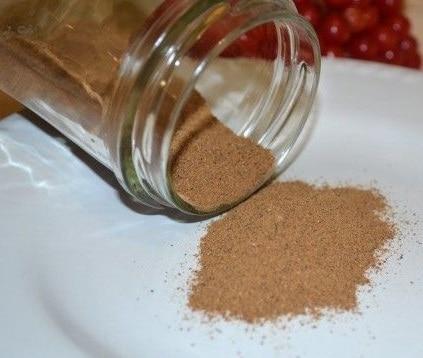
- dry;
- fry;
- marinate;
- extinguish;
- canning;
- freeze.
They collect mainly hats, as they are useful, clean, do not crumble
It is important to have time to cook the mushrooms no later than 3 hours after harvesting, since by that time they will darken and become inedible. Slow cooking helps preserve flavor and healing properties.
Some cooks make a seasoning from dung beetle. Dry mushrooms are ground into powder, other ingredients are added. The smell of the spice is similar to that of champignons.
Few dare to eat the mushroom. Its repulsive appearance, ignorance of the rules of preparation, transience made the shimmering dung beetle unpopular.
White dung
- A conditionally edible mushroom with a shaggy top, painted in a whitish tone. The diameter is 10 cm, this is the maximum value. Initially, the top is shaped like a spindle, then smoothly flows into the bell type. Over the course of the life cycle, it does not become widespread.
- The leg is painted in white, stretches up to 15 cm in height. It is located strictly along the central part. The inner part is empty, in the middle there is a beading, but it is not always clearly visible.
- White fruiting bodies are found in a huge volume. These are entire colonies that grow in meadows, garden plots and near houses. They are found on manure and near garbage dumps. Only young animals are subject to gathering, until they have become inky.
In today's material, we have studied a representative of the mushroom family, which received its postscript "inedible" due to the lack of such pulp. There is no point in subjecting these fruiting bodies to gathering and processing, because nothing can be obtained from them. The white dung beetle, which is considered to be a conditionally edible specimen and is found much more often than its predecessor, is considered a companion.
The action of the mushroom with alcohol and use for alcohol dependence
Crumbling dung are not compatible with alcohol. They contain substances that cause poisoning. The first signs include:
- temperature increase;
- tachycardia;
- vomiting;
- speech disorder;
- deterioration of vision.
Alcoholic drinks are allowed to be consumed several days after eating mushrooms.
The medicine for alcoholism is used in one of the forms:
- rectal (suppositories);
- powdery;
- capsule;
- in the form of drinking solutions.
Medicines made at home should not contain alcohol. Everything is prepared on the water. Treatment for alcohol addiction with mushrooms is not suitable if a person suffers from cardiovascular diseases, has problems with the stomach, liver, kidneys, and diseases of the respiratory system. An allergic reaction to the mushroom is not excluded.
Varieties and twins
The species composition of the Koprinus genus is constantly being revised. Some varieties, originally classified as dung beetles, were later isolated into separate genera or even transferred to other families; in relation to others, discussions are still underway.
Of course, there is no need to study and memorize all varieties of dung beetles, it is enough to be able to recognize only the most common of them
In addition, as with other mushrooms, in this case it is very important to know what to confuse Koprinus with, paying, of course, special attention to its inedible and poisonous counterparts.
Dung beetle white
Almost the only species of dung beetle that is unequivocally classified as edible is Coprinus comatus. The appearance of this mushroom is so characteristic that it is almost impossible to confuse it with any dangerous double.
You will be interested to know how to make delicious porcini mushroom soup.
Features:
- height 5–20 cm;
- egg-shaped cap (in young specimens - in the form of a spindle), always closed, snow-white with possible shades of grayish or beige, smooth and darker in the upper part, decorated with flaky scales over the rest of the area (because of this, the second name of the mushroom is shaggy dung beetle) ;
- the leg is white, thin (up to 2 cm) and long (up to 30 cm);
- pleasant "edible" smell;
- very fast growth (4-5 cm per day);
- harvest season - from late spring to mid-autumn;
- the place of growth - roadsides, orchards, vegetable gardens, fields, although it is also found in the forest.
It is worth saying that there is another species of dung beetles with a similar name - Coprinus niveus. He also has a white color, but his cap is smooth and as if dusted with flour, which is easily washed off. This species is classified as inedible.
Video: white dung beetle
Dung beetle gray
It is to the gray dung beetle (Coprinus atramentarius) that the name "ink mushroom" is best suited.
It is characterized by the following features:
- the diameter of the cap is 3–7 cm, the shape changes as it grows from ovoid to bell-shaped;
- the color of the cap is grayish brown, the top is darker;
- thin strips diverge from the top of the cap to the edges, which in adult mushrooms transform into cracks, after which the edges of the cap between these cracks rise up;
- plates are numerous, wide; in young mushrooms they are white, in adults they are brown, and after the onset of autolysis they are black;
- stem height 12–16 cm, thickness 1 cm, structure soft, watery, off-white color along the entire length, and in the lower part with reddish-brown blotches;
- the aroma is pleasant;
- shelf life is minimal: after collection, complete autolysis occurs in just a few hours.
Coprinus atramentarius is classified as a conditionally edible mushroom.
Video: gray dung
Romanesi dung
Another common species is very similar to gray dung beetle - Coprinopsis romagnesiana. Its main difference is a more pronounced "shaggy" (according to this quality, the Romagnesi is similar to the white dung beetle). The scales are dark brown with a possible tint towards orange or brown. In young mushrooms, the "fringe" fits tightly to the cap, but as it ripens, it becomes more fluffy at the edges. The leg is white, with a slight hairiness and, in some cases, with a seal in the lower part.
Check out the recipe for stewed potatoes with mushrooms.
The average size of the fungus is 6–12 cm in height, the thickness of the leg is up to 1.5 cm. Another feature by which Coprinopsis romagnesiana can be distinguished from gray dung beetle is the almost complete absence of smell (as well as taste). The fruiting period usually occurs in spring and summer, but there are repeated periods of appearance of these mushrooms in the second half of autumn. Like gray dung beetle, Coprinus romanesi is conditionally edible.
Dung beetle twins
In addition to those mentioned above, in the literature you can find descriptions and photographs of the following varieties of dung beetle and its counterparts:
| Russian name | Latin name | Consumer properties (according to various sources) |
| ordinary, or ash gray | coprinus cinereusc | conditionally edible |
| shimmery | coprinus micaceus | conditionally edible / inedible |
| home | coprinus domesticus | inedible |
| absent-minded | coprinellus disseminatus | inedible |
| narcotic | coprinus narcoticus | inedible |
| fluffy, or furry | coprinopsis lagopus | inedible |
| folded | parasola plicatilis | inedible |
| resinous, or magpie, or variegated | coprinopsis picacea | inedible |
| willow | coprinellus truncorum | inedible / poisonous |
Scattered dung beetle description
The hat is very tiny - its diameter is 0.5-1.5 centimeters. It is folded, bell-shaped.Young mushrooms are light cream, with age they acquire a gray color.
The leg has a length of 1-3 centimeters, it is very fragile and thin. The color of the leg is grayish-white. The pulp is very thin, it has practically no smell and taste. The plates are grayish at first, they gradually darken, and by the end they decompose. Unlike their fellows, scattered dung beetles practically do not emit a dark liquid during decomposition. Black spore powder.

Places of distribution and time of fruiting of scattered dung beetles
Fruiting of scattered dung beetles is observed from spring to autumn. These mushrooms are found on rotting wood. They usually settle in large colonies and cover a uniformly large area. Individually, they never grow, in the singular they simply do not exist or have not been noticed.
How to recognize scattered dung beetle
The possibility of error is excluded due to the fact that scattered dung beetles settle in large colonies and evenly cover the entire surface of stumps or trees.

Assessment of scattered dung beetles
Scattered dung beetles are considered inedible mushrooms because of their tiny size, there is practically no pulp in them.
Kindred of the scattered dung beetles
Home dung is an inedible mushroom. Its height is 3-10 centimeters, and the diameter of the cap is 3-5 centimeters. Its shape can be ellipsoidal, ovoid and bell-shaped. The hat is cracking, radially ribbed. The color of the cap is pale brown, gray-brown or ocher brown. The stem is hard-fibrous, hollow, whitish in color.

Domestic dungs grow on dead birch or aspen wood, and they can also be seen next to wooden buildings. They settle alone; they are less common in small groups. The fruiting period is May-September.
White dung is a conditionally edible mushroom. His hat is shaggy, white, 5-12 centimeters high. Its shape is fusiform at first, after which it becomes bell-shaped, over time it practically does not straighten out. At the start, the cap of the mushroom turns into ink, and the last one to disappear is the dark bump in the center. The leg is hollow, white, up to 15 centimeters high. There is a movable white ring on the leg, which is not always clearly visible.

White dung beetles can be found in stunning numbers. They grow in vegetable gardens, orchards, fields, lawns, garbage dumps and dung heaps. In the forests, these mushrooms are rarely found. Collect only young dung beetles that have not yet begun to turn into ink.
Description of the mushroom
Flickering dung (Latin Coprinellus micaceus) is a mushroom belonging to the Psathyrellaceae family, the genus Coprinellus (Coprinellus or Dung). Previously, it was assigned to the Coprinaceae family, now disbanded. Another name for Coprinellus micaceus is crumbling dung.
At an early stage of development, the cap is ovoid, then bell-shaped, but does not fully open. Its diameter varies up to 1 to 4 cm. There are caps of yellow-brown, yellow-brown color. In the central part, the color is more intense, brightens towards the edges. The outer surface of the cap is uniform with traces of folds from the plates.
The lower part of the cap (hymenophore) is light and has a lamellar structure. Flickering dung is susceptible to autolysis: the hymenophore quickly darkens and decomposes. The flesh on the cut is thin, tender, fragile, fibrous closer to the stem. Has a white or whitish-gray color, sourish in taste, does not smell. The leg is long, white, empty inside. On the surface it is smooth, silky downwards. There is no ring.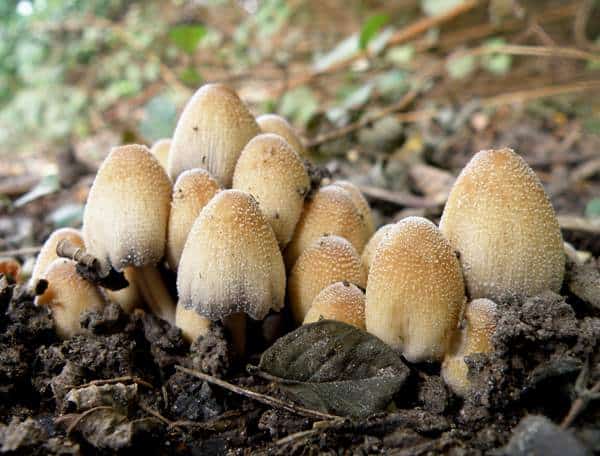
A bit of history
Mushrooms were described in the first half of the 19th century by the French botanist Jean Baptiste François Pierre Billiard.

